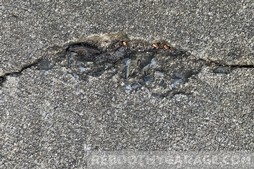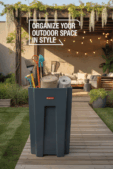What’s Wrong With My Garage Floor?
Once you know what’s causing the problems with your garage floor, you can fix them. Those pockmarks, chalky stains, and peeling areas are much easier to handle once you know what you’re looking at. The most common issues are simpler to repair than you might think.
The four main types of garage floor damage are cracking, spalling/pitting, low spots, and stains. Each problem has a unique cause and a clear path to repair. Most of these cosmetic issues are things you can handle yourself in a weekend.
You can fix everything from small cracks to surface pitting. The key is to also know the warning signs of a deeper issue that might need a professional’s help. This guide will walk you through identifying each problem so you can get started with confidence.
We’ll explore what causes these flaws and show you the right solutions. Ready to take back your garage floor? Let’s start by figuring out the damage.

Learn how to fix these common problems in our detailed guides:
- Cracking: How Do You Fix Garage Floor Cracks?
- Spalling and Pitting: How Do You Fix Garage Floor Spalling and Pitting?
- Low Spots: How Do You Fix Low Spots in Concrete?
Why Does My Concrete Floor Have Cracks?
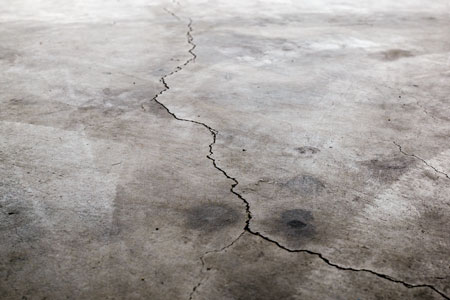
Cracks are the long, thin splits that appear on the surface of your concrete. As a concrete floor gets older, some cracking is almost certain to happen. The concrete naturally expands and shrinks with temperature swings, which causes these splits to form over time.
However, a new floor should not crack. If you see cracks in a recently poured slab, it points to a problem with how it was installed. A few common mistakes are often the cause.
The concrete mix might have been too wet, creating a weak slab. The floor could also have dried too quickly, causing it to shrink and crack. Another common issue is poorly placed control joints, which are meant to guide cracking, or pouring the concrete onto frozen ground.
Knowing the cause helps you find the right solution. For most cracks that don’t affect the structure of your home, a DIY repair is a simple project that makes your floor strong and look good again.
What Causes Pitting and Flaking on My Floor?
If your floor’s surface is flaking away or has small holes, you’re likely dealing with spalling or pitting. Spalling happens because of water freezing and thawing. Water gets into the concrete, freezes, expands, and pops off the top layer. This exposes the rougher concrete mix underneath.
This problem is often made worse by deicing salts from your car in the winter. These salts can speed up the damage to the concrete surface.
Pitting, on the other hand, is a series of small but often deeper holes. It usually points to a mistake during installation, like using a bad concrete mix or poor finishing techniques that left the surface weak.
While their causes are different, they can look similar, creating a rough, pockmarked texture. The good news is that both spalling and pitting can be repaired to give you a smooth, strong surface once again.
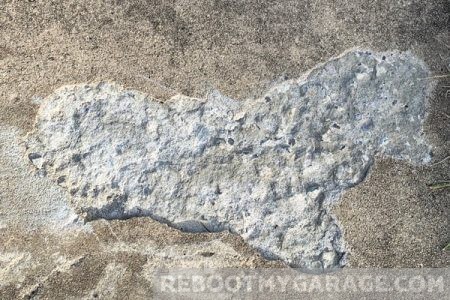

Why Are There Puddles and Dips in My Garage?
Low spots are dips or sagging areas in the concrete. These areas often collect water, creating puddles that don’t dry. The common cause is either poor finishing when the floor was first installed or the ground settling unevenly under the slab.
As long as the dip isn’t a sign of a sinkhole or a major problem under the floor, you can fix it. You have a couple of options. You can use a grinder to grind down the high spots around the dip, which levels the area.
Another popular method is to use a patching compound to fill the low spot, making it level with the rest of the floor. This approach adds new material to create a flat, even surface.
Before you start, it’s important to figure out if the low spot points to a bigger problem. Our guide on how to fix a low spot in your garage floor will help you check the situation and pick the right repair method.

What Are These White, Chalky Stains on My Concrete?
Those chalky white stains on your garage floor are clues about what’s happening inside the concrete. Two common causes are laitance and efflorescence, and both are related to water moving through the slab.
Laitance is a weak, dusty layer of cement and sand that rises to the top as the concrete cures. If the original concrete mix had too much water, this layer becomes extra crumbly and sandy. A little dust on an unsealed floor is normal, but a surface that’s always powdery is a sign of a problem.

Efflorescence is different. It’s a deposit of salt stains that appear after water evaporates. Groundwater can push salts from inside the concrete to the surface. When the water evaporates, it leaves the white, chalky salt behind.
While it’s not damaging on its own, if efflorescence keeps coming back, it’s a clear sign of a moisture problem under your floor. If this is a constant issue, you may need to check for a problem with the moisture barrier under the slab.

When to Call a Professional for Help

While most floor issues are just cosmetic, some are signs of serious structural problems that need a professional. It’s vital to know the difference between a simple DIY fix and a major issue. If your floor has a lot of damage, don’t wait to call an expert for a consultation.
Look for these warning signs. Are there cracks where one side is higher than the other? This indicates a major settling issue. Do you have low spots with crumbling concrete that seem to be getting worse?
A garage floor that’s always wet or has a puddle that never goes away are also big red flags. If your floor shows any of these signs, there is likely a major problem underneath the slab.
These issues can point to water buildup or major soil movement beneath your garage. This can lead to a huge structural problem. In this case, talk to a concrete professional or structural engineer to find out what’s wrong. Applying a simple patch to a foundation problem will always fail, because no amount of epoxy or mortar can stop that kind of force.
Should I Apply an Epoxy Coating Myself?
You can get a beautiful, glossy, showroom-quality floor. However, applying an epoxy coating takes the right tools, timing, weather, and experience to do it right. Many DIY epoxy projects fail because of bad prep work or moisture problems.
Without thorough prep work, epoxy coatings tend to peel, bubble, and trap air pockets. For a successful DIY epoxy project, preparation is the most important step. This means cleaning, degreasing, and etching the concrete so the coating can stick for good.
If you’ve thought about using epoxy, it’s a good idea to weigh the pros and cons. We have several articles to help you decide:
- Pros and Cons of Applying Epoxy to the Garage Floor
- I Will Never Epoxy My Garage Floor (What I Will Do Instead)
- Garage Floor Coatings: Epoxy vs. Paint, Which is Better?
If you want that perfect finish, think about hiring a professional garage floor refinisher, not just a handyman. They have industrial equipment and the know-how to give you a long-lasting, magazine-worthy result. As an alternative, high-quality floor tiles or mats can give you a great-looking, protective surface with less risk.
Why Does Concrete Behave This Way?
Besides major water issues, most concrete damage comes from its natural properties. Cracking and flaking are often caused by temperature changes, de-icing salts you track in, and incorrect placement of expansion joints. Mistakes from the original installation, like a mix with too much water or a bad drying time, also create weak spots.
Concrete is incredibly strong when you push down on it, which is why it’s used for everything from roads to buildings. However, it is not flexible. Concrete will not stretch or bend; it will crack under pressure. This is a main reason why cracking is so common.
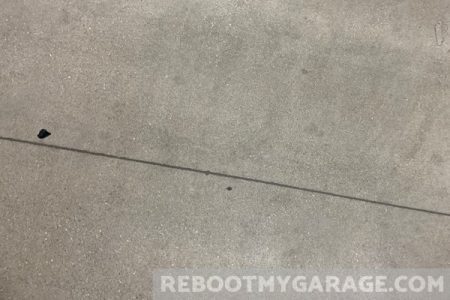
To handle this, installers put expansion and contraction joints in the slab. These seams give the concrete room to expand and shrink with temperature changes, controlling where cracks happen. It is very important not to fill these joints with hard materials when making repairs; the concrete needs that space to move.
Finally, concrete is porous, like a sponge. If you pour water on an unsealed floor, it will soak into the surface. A vapor barrier should be put under the slab to keep it from pulling moisture from the ground. If your floor is always damp, you may have a hole in this barrier or another water issue.
What’s the Difference Between Cement and Concrete?
People often use the words “cement” and “concrete” to mean the same thing, but they are not the same. Knowing the difference helps you choose the right repair products. Think of it like this: cement is like flour, and concrete is like the finished cake.
Cement is a powder that acts as a binder, and it’s a key ingredient that gives concrete its strength. On its own, it’s just a fine powder. Concrete is the final mix of cement, water, and aggregates like sand and stone.
Your garage floor is made of concrete, not just cement. Some newer concrete mixes also have special additives to give them different properties. This helps you understand why you can’t just patch old concrete with new concrete; you need special repair materials designed for the job.
Which Repair Products and Methods Should I Avoid?
When you’re ready to fix your floor, using the wrong product can cause more work later. First, you cannot repair old concrete with regular new concrete. It won’t stick correctly, and the patch will break apart quickly.
Avoid using self-leveling sealants to repair cracks that aren’t moving. These products are made for flexible control joints, not for filling solid cracks. Also, stay away from most water-based and latex-based products for this kind of repair.
Many of these products are hard to sand or paint, can shrink over time, and might pull away from the repair. Stick to high-quality epoxy or polymer-modified repair materials for a lasting fix that you can sand smooth for a clean finish.
Finally, do not use muriatic acid to clean your floor. This is a harsh chemical for etching concrete, but it will not dissolve oil or common garage stains. It will just eat away at your concrete. There are much safer and better cleaning and etching products made for homeowners.
What Are the Best Products to Fix My Garage Floor?
So, what should you use? For cracks and other surface damage, your two best choices are epoxy-based repair kits and polymer-modified cement patches.
Epoxy repair kits have two parts: a resin and a hardener. When you mix them, they create a hard, sandable, and paintable material that is not porous and resists oils and salts. Epoxy cures quickly, so mix it in small amounts that you can use right away.
A word of caution: as epoxy cures, it gets very hot and can cause chemical burns. Always wear protective gloves and safety glasses when working with epoxy.
Polymer-modified concrete is a cement patch mixed with special polymer additives. These additives help it stick securely to old concrete. It usually comes as a powder that you mix with water or a liquid polymer agent.
This material takes longer to cure than epoxy, giving you more time to work with it, especially for larger areas. Both options work well, but remember that neither will perfectly match the color of your floor. If looks are a top priority, plan to paint, coat, or cover the floor after the repairs are done.
How to Protect Your Floor After the Repair
After you’ve fixed your floor, the final step is to protect your hard work. If you’re not worried about how it looks, you can leave it alone. However, applying a “densifying sealer” is a great way to protect your floor from future stains, road salt, and deicers. It also hardens the surface and reduces dust.
One of the best densifiers is Sila-Tek 3500. A product like this makes your garage floor stronger and more resistant to damage. One gallon can treat up to 1,000 square feet, making it an affordable way to protect your repair. You can find it on Amazon here.
To give the floor a whole new look, you can resurface it with a concrete topcoat for a fresh, even appearance. Another excellent choice is covering the floor with durable, interlocking plastic tiles. They look great, protect the concrete underneath, and can be taken apart and moved if you ever move, which is perfect for renters.
Finally, think about high-quality garage floor mats made to contain water, ice, and snow that falls off your car. These containment mats catch the mess, which you can easily sweep out of the garage. This keeps your floor clean, dry, and protected for years to come.


